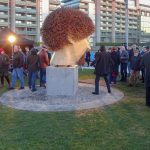SMITHFIELD AREA OF DUBLIN
I have no idea as to why it is named Coke Lane but about ten years ago a gentleman came out of a doorway on this street/laneway and told me to go back to America and to stop taking photographs that disrespected the people of Ireland. I decided that it was best to keep my mouth shut and to move on and to return at a later date. Since then I visit on a regular basis but not much has changed over the years.
I am frequently mistaken as being American and have never worked out why.
![ANOTHER VISIT TO COKE LANE [SMITHFIELD AREA OF DUBLIN]-228135-1](https://excellentstreetimages.com/NorthOfTheRiverWordPress/wp-content/uploads/2024/02/ANOTHER-VISIT-TO-COKE-LANE-SMITHFIELD-AREA-OF-DUBLIN-228135-1-150x150.jpg)
![ANOTHER VISIT TO COKE LANE [SMITHFIELD AREA OF DUBLIN]-228131-1 ANOTHER VISIT TO COKE LANE [SMITHFIELD AREA OF DUBLIN]-228131-1](https://excellentstreetimages.com/NorthOfTheRiverWordPress/wp-content/uploads/2024/02/ANOTHER-VISIT-TO-COKE-LANE-SMITHFIELD-AREA-OF-DUBLIN-228131-1.jpg)
![ANOTHER VISIT TO COKE LANE [SMITHFIELD AREA OF DUBLIN]-228132-1 ANOTHER VISIT TO COKE LANE [SMITHFIELD AREA OF DUBLIN]-228132-1](https://excellentstreetimages.com/NorthOfTheRiverWordPress/wp-content/uploads/2024/02/ANOTHER-VISIT-TO-COKE-LANE-SMITHFIELD-AREA-OF-DUBLIN-228132-1.jpg)
![ANOTHER VISIT TO COKE LANE [SMITHFIELD AREA OF DUBLIN]-228133-1 ANOTHER VISIT TO COKE LANE [SMITHFIELD AREA OF DUBLIN]-228133-1](https://excellentstreetimages.com/NorthOfTheRiverWordPress/wp-content/uploads/2024/02/ANOTHER-VISIT-TO-COKE-LANE-SMITHFIELD-AREA-OF-DUBLIN-228133-1.jpg)
![ANOTHER VISIT TO COKE LANE [SMITHFIELD AREA OF DUBLIN]-228136-1 ANOTHER VISIT TO COKE LANE [SMITHFIELD AREA OF DUBLIN]-228136-1](https://excellentstreetimages.com/NorthOfTheRiverWordPress/wp-content/uploads/2024/02/ANOTHER-VISIT-TO-COKE-LANE-SMITHFIELD-AREA-OF-DUBLIN-228136-1.jpg)
![ANOTHER VISIT TO COKE LANE [SMITHFIELD AREA OF DUBLIN]-228134-1 ANOTHER VISIT TO COKE LANE [SMITHFIELD AREA OF DUBLIN]-228134-1](https://excellentstreetimages.com/NorthOfTheRiverWordPress/wp-content/uploads/2024/02/ANOTHER-VISIT-TO-COKE-LANE-SMITHFIELD-AREA-OF-DUBLIN-228134-1.jpg)
![ANOTHER VISIT TO COKE LANE [SMITHFIELD AREA OF DUBLIN]-228135-1 ANOTHER VISIT TO COKE LANE [SMITHFIELD AREA OF DUBLIN]-228135-1](https://excellentstreetimages.com/NorthOfTheRiverWordPress/wp-content/uploads/2024/02/ANOTHER-VISIT-TO-COKE-LANE-SMITHFIELD-AREA-OF-DUBLIN-228135-1.jpg)
![ANOTHER VISIT TO COKE LANE [SMITHFIELD AREA OF DUBLIN]-228137-1 ANOTHER VISIT TO COKE LANE [SMITHFIELD AREA OF DUBLIN]-228137-1](https://excellentstreetimages.com/NorthOfTheRiverWordPress/wp-content/uploads/2024/02/ANOTHER-VISIT-TO-COKE-LANE-SMITHFIELD-AREA-OF-DUBLIN-228137-1.jpg)
![ANOTHER VISIT TO COKE LANE [SMITHFIELD AREA OF DUBLIN]-228138-1 ANOTHER VISIT TO COKE LANE [SMITHFIELD AREA OF DUBLIN]-228138-1](https://excellentstreetimages.com/NorthOfTheRiverWordPress/wp-content/uploads/2024/02/ANOTHER-VISIT-TO-COKE-LANE-SMITHFIELD-AREA-OF-DUBLIN-228138-1.jpg)
![ANOTHER VISIT TO COKE LANE [SMITHFIELD AREA OF DUBLIN]-228139-1 ANOTHER VISIT TO COKE LANE [SMITHFIELD AREA OF DUBLIN]-228139-1](https://excellentstreetimages.com/NorthOfTheRiverWordPress/wp-content/uploads/2024/02/ANOTHER-VISIT-TO-COKE-LANE-SMITHFIELD-AREA-OF-DUBLIN-228139-1.jpg)
![ANOTHER VISIT TO COKE LANE [SMITHFIELD AREA OF DUBLIN]-228141-1 ANOTHER VISIT TO COKE LANE [SMITHFIELD AREA OF DUBLIN]-228141-1](https://excellentstreetimages.com/NorthOfTheRiverWordPress/wp-content/uploads/2024/02/ANOTHER-VISIT-TO-COKE-LANE-SMITHFIELD-AREA-OF-DUBLIN-228141-1.jpg)
![ANOTHER VISIT TO COKE LANE [SMITHFIELD AREA OF DUBLIN]-228142-1 ANOTHER VISIT TO COKE LANE [SMITHFIELD AREA OF DUBLIN]-228142-1](https://excellentstreetimages.com/NorthOfTheRiverWordPress/wp-content/uploads/2024/02/ANOTHER-VISIT-TO-COKE-LANE-SMITHFIELD-AREA-OF-DUBLIN-228142-1.jpg)
![ANOTHER VISIT TO COKE LANE [SMITHFIELD AREA OF DUBLIN]-228143-1 ANOTHER VISIT TO COKE LANE [SMITHFIELD AREA OF DUBLIN]-228143-1](https://excellentstreetimages.com/NorthOfTheRiverWordPress/wp-content/uploads/2024/02/ANOTHER-VISIT-TO-COKE-LANE-SMITHFIELD-AREA-OF-DUBLIN-228143-1.jpg)
![ANOTHER VISIT TO COKE LANE [SMITHFIELD AREA OF DUBLIN]-228144-1 ANOTHER VISIT TO COKE LANE [SMITHFIELD AREA OF DUBLIN]-228144-1](https://excellentstreetimages.com/NorthOfTheRiverWordPress/wp-content/uploads/2024/02/ANOTHER-VISIT-TO-COKE-LANE-SMITHFIELD-AREA-OF-DUBLIN-228144-1.jpg)
![ANOTHER VISIT TO COKE LANE [SMITHFIELD AREA OF DUBLIN]-228140-1 ANOTHER VISIT TO COKE LANE [SMITHFIELD AREA OF DUBLIN]-228140-1](https://excellentstreetimages.com/NorthOfTheRiverWordPress/wp-content/uploads/2024/02/ANOTHER-VISIT-TO-COKE-LANE-SMITHFIELD-AREA-OF-DUBLIN-228140-1.jpg)
![DID SOMEONE USE LEGO BRICKS TO REPAIR A WALL [OR WAS IT A FORM OF URBAN ART] 002](https://excellentstreetimages.com/NorthOfTheRiverWordPress/wp-content/uploads/2024/01/DID-SOMEONE-USE-LEGO-BRICKS-TO-REPAIR-A-WALL-OR-WAS-IT-A-FORM-OF-URBAN-ART-226629-150x150.jpg)
![DID SOMEONE USE LEGO BRICKS TO REPAIR A WALL [OR WAS IT A FORM OF URBAN ART] 003 DID SOMEONE USE LEGO BRICKS TO REPAIR A WALL [OR WAS IT A FORM OF URBAN ART] 003](https://excellentstreetimages.com/NorthOfTheRiverWordPress/wp-content/uploads/2024/01/DID-SOMEONE-USE-LEGO-BRICKS-TO-REPAIR-A-WALL-OR-WAS-IT-A-FORM-OF-URBAN-ART-226628-scaled-1600x1200.jpg)
![DID SOMEONE USE LEGO BRICKS TO REPAIR A WALL [OR WAS IT A FORM OF URBAN ART] 002 DID SOMEONE USE LEGO BRICKS TO REPAIR A WALL [OR WAS IT A FORM OF URBAN ART] 002](https://excellentstreetimages.com/NorthOfTheRiverWordPress/wp-content/uploads/2024/01/DID-SOMEONE-USE-LEGO-BRICKS-TO-REPAIR-A-WALL-OR-WAS-IT-A-FORM-OF-URBAN-ART-226629-scaled-1600x1200.jpg)
![DID SOMEONE USE LEGO BRICKS TO REPAIR A WALL [OR WAS IT A FORM OF URBAN ART] 001 DID SOMEONE USE LEGO BRICKS TO REPAIR A WALL [OR WAS IT A FORM OF URBAN ART] 001](https://excellentstreetimages.com/NorthOfTheRiverWordPress/wp-content/uploads/2024/01/DID-SOMEONE-USE-LEGO-BRICKS-TO-REPAIR-A-WALL-OR-WAS-IT-A-FORM-OF-URBAN-ART-226627-scaled-1600x1200.jpg)
![THIS IS EARL PLACE BEHIND CLERYS [THIS MAY BE UNFAMILIAR TO THE MAJORITY OF DUBLINERS]-225679-1](https://excellentstreetimages.com/NorthOfTheRiverWordPress/wp-content/uploads/2023/12/THIS-IS-EARL-PLACE-BEHIND-CLERYS-THIS-MAY-BE-UNFAMILIAR-TO-THE-MAJORITY-OF-DUBLINERS-225679-1-150x150.jpg)
![THIS IS EARL PLACE BEHIND CLERYS [THIS MAY BE UNFAMILIAR TO THE MAJORITY OF DUBLINERS]-225673-1 THIS IS EARL PLACE BEHIND CLERYS [THIS MAY BE UNFAMILIAR TO THE MAJORITY OF DUBLINERS]-225673-1](https://excellentstreetimages.com/NorthOfTheRiverWordPress/wp-content/uploads/2023/12/THIS-IS-EARL-PLACE-BEHIND-CLERYS-THIS-MAY-BE-UNFAMILIAR-TO-THE-MAJORITY-OF-DUBLINERS-225673-1.jpg)
![THIS IS EARL PLACE BEHIND CLERYS [THIS MAY BE UNFAMILIAR TO THE MAJORITY OF DUBLINERS]-225674-1 THIS IS EARL PLACE BEHIND CLERYS [THIS MAY BE UNFAMILIAR TO THE MAJORITY OF DUBLINERS]-225674-1](https://excellentstreetimages.com/NorthOfTheRiverWordPress/wp-content/uploads/2023/12/THIS-IS-EARL-PLACE-BEHIND-CLERYS-THIS-MAY-BE-UNFAMILIAR-TO-THE-MAJORITY-OF-DUBLINERS-225674-1.jpg)
![THIS IS EARL PLACE BEHIND CLERYS [THIS MAY BE UNFAMILIAR TO THE MAJORITY OF DUBLINERS]-225675-1 THIS IS EARL PLACE BEHIND CLERYS [THIS MAY BE UNFAMILIAR TO THE MAJORITY OF DUBLINERS]-225675-1](https://excellentstreetimages.com/NorthOfTheRiverWordPress/wp-content/uploads/2023/12/THIS-IS-EARL-PLACE-BEHIND-CLERYS-THIS-MAY-BE-UNFAMILIAR-TO-THE-MAJORITY-OF-DUBLINERS-225675-1.jpg)
![THIS IS EARL PLACE BEHIND CLERYS [THIS MAY BE UNFAMILIAR TO THE MAJORITY OF DUBLINERS]-225676-1 THIS IS EARL PLACE BEHIND CLERYS [THIS MAY BE UNFAMILIAR TO THE MAJORITY OF DUBLINERS]-225676-1](https://excellentstreetimages.com/NorthOfTheRiverWordPress/wp-content/uploads/2023/12/THIS-IS-EARL-PLACE-BEHIND-CLERYS-THIS-MAY-BE-UNFAMILIAR-TO-THE-MAJORITY-OF-DUBLINERS-225676-1.jpg)
![THIS IS EARL PLACE BEHIND CLERYS [THIS MAY BE UNFAMILIAR TO THE MAJORITY OF DUBLINERS]-225677-1 THIS IS EARL PLACE BEHIND CLERYS [THIS MAY BE UNFAMILIAR TO THE MAJORITY OF DUBLINERS]-225677-1](https://excellentstreetimages.com/NorthOfTheRiverWordPress/wp-content/uploads/2023/12/THIS-IS-EARL-PLACE-BEHIND-CLERYS-THIS-MAY-BE-UNFAMILIAR-TO-THE-MAJORITY-OF-DUBLINERS-225677-1.jpg)
![THIS IS EARL PLACE BEHIND CLERYS [THIS MAY BE UNFAMILIAR TO THE MAJORITY OF DUBLINERS]-225678-1 THIS IS EARL PLACE BEHIND CLERYS [THIS MAY BE UNFAMILIAR TO THE MAJORITY OF DUBLINERS]-225678-1](https://excellentstreetimages.com/NorthOfTheRiverWordPress/wp-content/uploads/2023/12/THIS-IS-EARL-PLACE-BEHIND-CLERYS-THIS-MAY-BE-UNFAMILIAR-TO-THE-MAJORITY-OF-DUBLINERS-225678-1.jpg)
![THIS IS EARL PLACE BEHIND CLERYS [THIS MAY BE UNFAMILIAR TO THE MAJORITY OF DUBLINERS]-225679-1 THIS IS EARL PLACE BEHIND CLERYS [THIS MAY BE UNFAMILIAR TO THE MAJORITY OF DUBLINERS]-225679-1](https://excellentstreetimages.com/NorthOfTheRiverWordPress/wp-content/uploads/2023/12/THIS-IS-EARL-PLACE-BEHIND-CLERYS-THIS-MAY-BE-UNFAMILIAR-TO-THE-MAJORITY-OF-DUBLINERS-225679-1.jpg)

